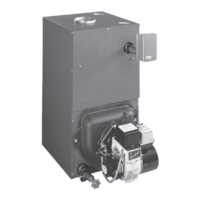22
NOZZLES AND ELECTRODES: Use the proper
size, spray angle, and spray pattern nozzle. Refer
to the recommended nozzle selection charts at
the end of this manual. To install a nozzle, remove
the nozzle line electrode assembly, if necessary
remove the retention ring assembly, and then
install and tighten the nozzle. Be careful not to
damage the electrode insulators or the bend the
electrode tips. After installing the nozzle, reas-
semble the nozzle line electrode assembly and
set the electrode tip spacing. Depending on the
burner purchased, the electrode tip spacing may
need to be set prior to reassembling the nozzle
line electrode assembly. Refer to the gures on
the following pages for setting the electrode tip
spacing on Beckett, Carlin, and Riello burners.
FINAL BURNER ADJUSTMENTS: Final burner
adjustments must be made using combustion
test instruments. Initial settings for the burner are
shown at the back of this manual.
Set the burner accordingly. Check the draft over
re to verify that it is between 0.01” WC and 0.02”
WC, otherwise adjust the draft as necessary. After
operating 10 minutes to warm up the boiler, use
the combustion test equipment to take a smoke
reading in the ue pipe between the boiler and
the draft regulator. The smoke reading should
be zero to a trace (Shell Bacharach Scale). At
times a new boiler requires more than 10 minutes
to burn clean due to the oil lm on the new heat
exchanger. If the smoke reading is zero, gradu-
ally close the burner’s air adjustment to obtain a
smoke reading showing a trace smoke reading.
Once the smoke reading is a trace, measure the
CO
2
and as an insurance margin increase the air
to sufciently reduce the CO
2
by 1/2% to 1%.
If a clean fire cannot be obtained, it will be
necessary to verify the burner head and electrode
alignment. Proper electrode alignment gures
are presented on the following pages. If the re
continues to be smoky, replace the nozzle with
a correct replacement.
Once the burner is completely adjusted, the
OperaTiNg THe BOiler
burner should be started and stopped several
times to assure good operation with no uttering
or rumbling. Verify that there are no oil leaks and
then record the nozzle size, oil pressure, combus-
tion readings, and air settings on a tag or label
that can be attached to the burner or, boiler.
OIL BURNER MAINTENANCE: For the Beckett
AFG, Carlin EZ1 or EZ2, and the Riello 40 F3, F5,
or F10 the following preventative maintenance
items should be performed annually, preferably
prior to the heating season.
1. Oil Burner Motor For Beckett and Carlin
burners, add 2 3 drops of non-detergent
electric motor oil to each oil cup located at the
front and rear of the motor (Riello burners are
permanently lubricated). Excessive oiling will
shorten the life expectancy of the motor.
2. Fuel Filter This should be replaced so as to
prevent contaminated fuel from reaching the
nozzle. A partially blocked fuel lter can cause
premature failure of the fuel pump.
3. Fuel Pump Unit Replace pump screen and clean
pump unit to maintain fuel delivery to the nozzle.
4. Ignition Electrodes Clean and adjust as per
manufacturer’s recommendations, so as to
maintain reliable ignition of oil.
5. Nozzle Replace so as to maintain safe and
reliable combustion efciency. Always replace
with the exact nozzle as required in the charts
in the back of this manual.
6. Fan and Blower Housing These must be kept
clean, free of dirt, lint and oil so as to maintain the
proper amount of air the fuel requires to burn.
7. Check the nal burner adjustments.
NOTE: If any component parts must be
replaced, always use parts recommended
by the burner manufacturer.

